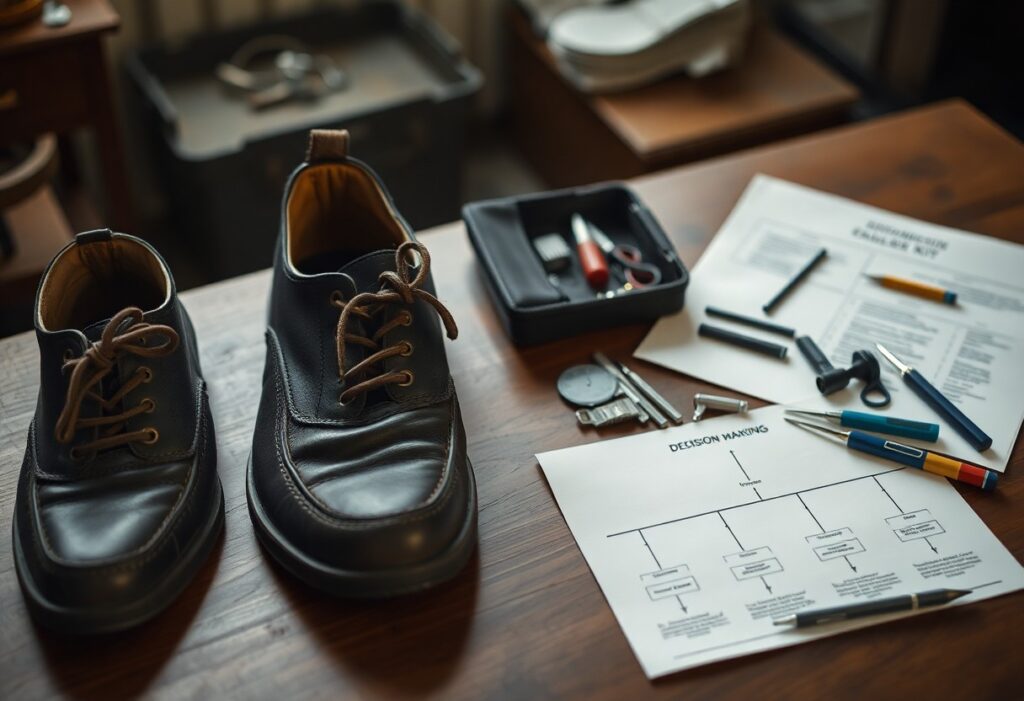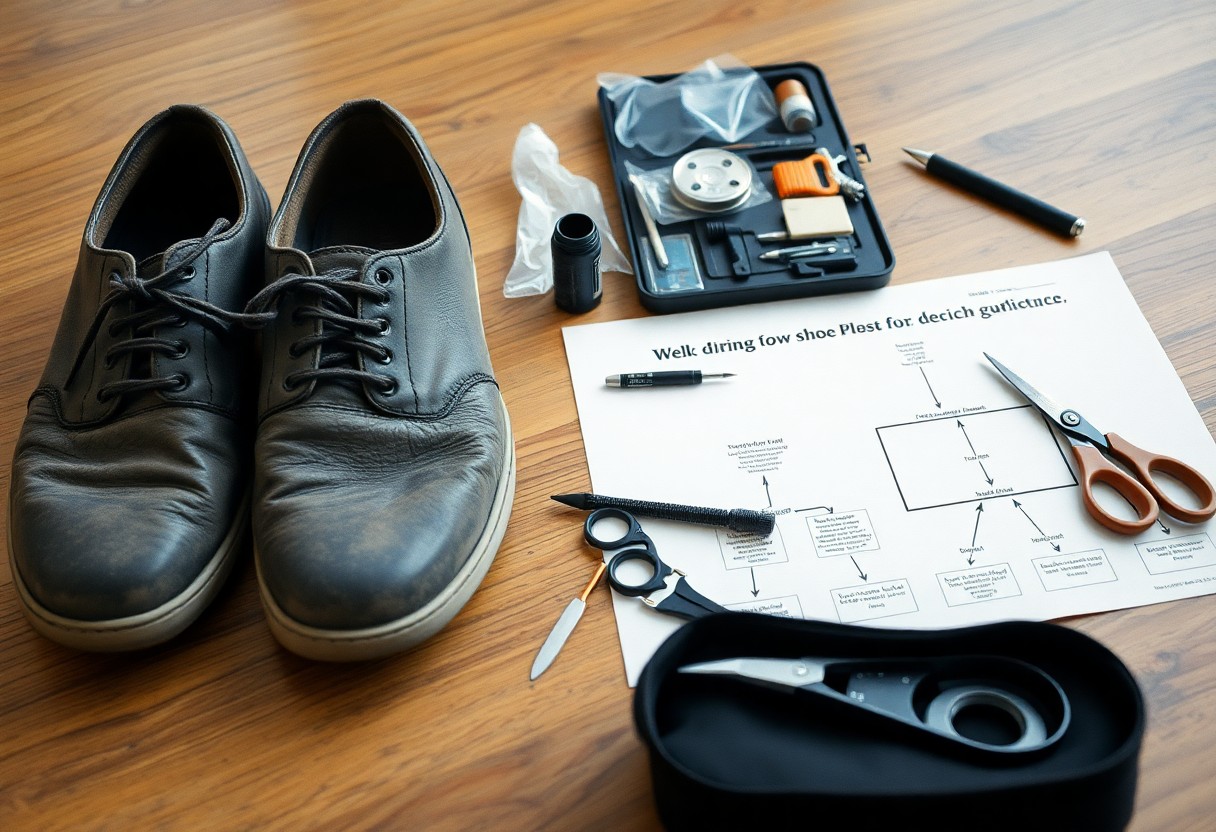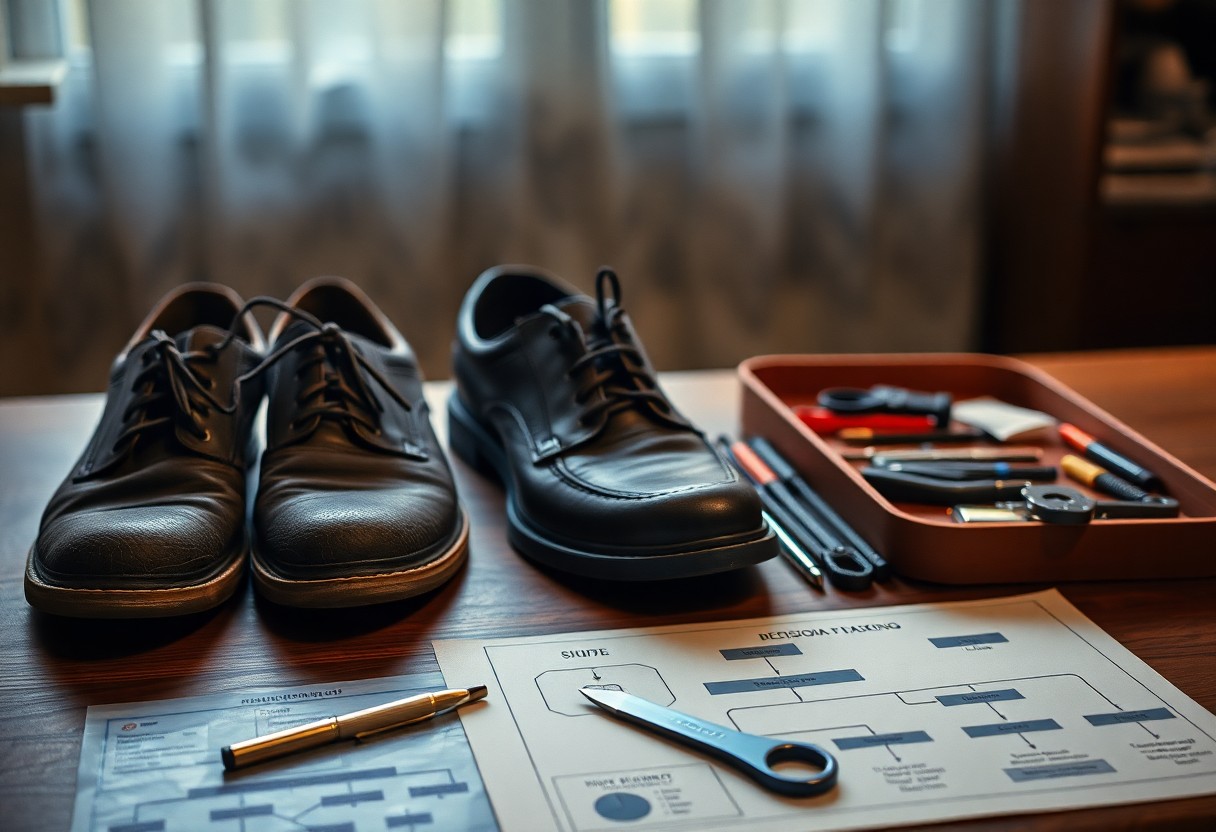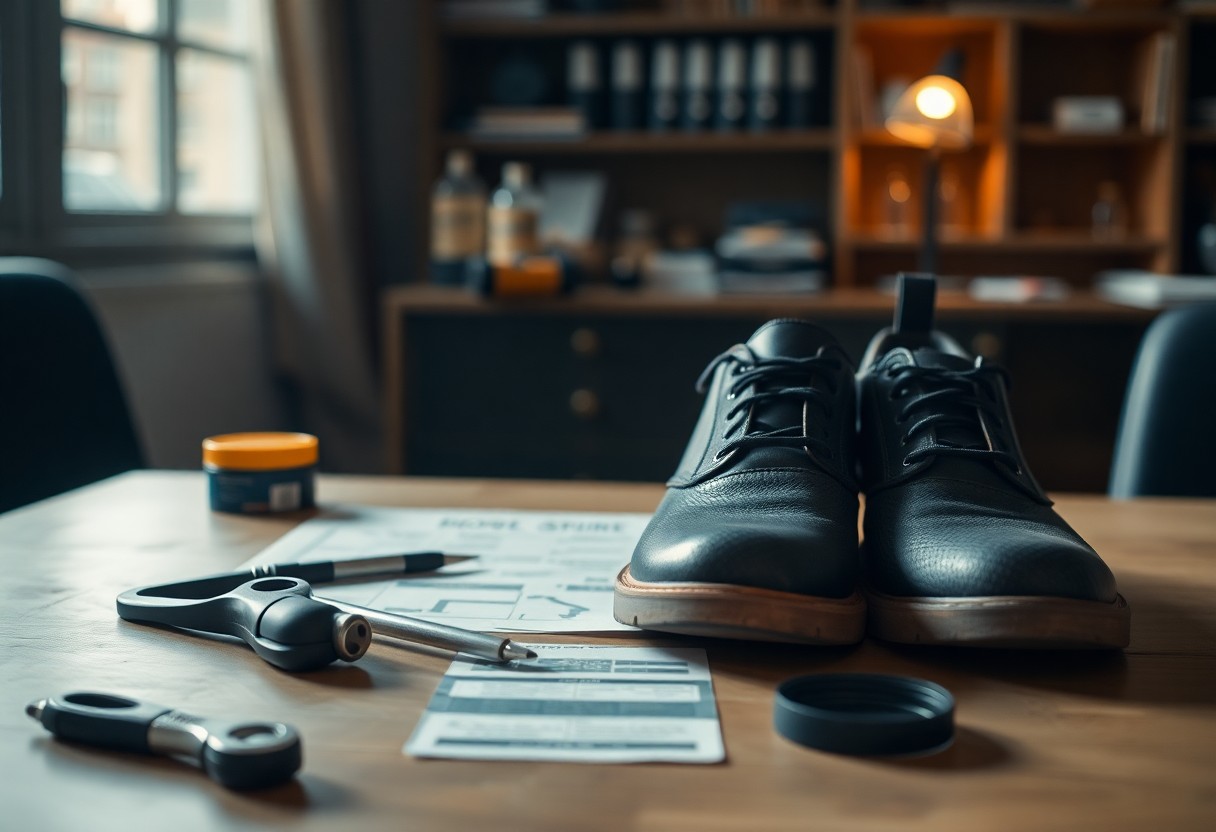
This comprehensive guide is designed to equip you with the essential knowledge needed to make informed decisions regarding your footwear's future. When faced with the challenge of worn-out shoes, the choice between repairing and replacing them can significantly impact your finances while also extending the lifespan of your cherished shoes. Your decision should be guided by critical factors such as the original quality of your shoes, the severity of the damage, and the repair costs involved. For instance, if you own high-quality leather shoes experiencing sole wear or heel damage, choosing to repair them may be the smarter financial option. Conversely, if the upper leather is severely damaged or there are multiple structural issues, opting for a replacement may be the more practical choice. Understanding these vital aspects will empower you to manage your footwear effectively and make economically sound choices.

Identify and Evaluate the Most Common Types of Shoe Damage
Before you decide whether to repair or replace your footwear, it's essential to recognize the common types of damage that can affect your beloved shoes. Footwear can deteriorate in several crucial areas, including soles, heels, uppers, and structural components. Being able to spot these problems early on can greatly improve your decision-making regarding necessary repairs, helping you maintain your shoes in optimal condition.
| Damage Type | Repair Possibility |
| Sole Wear | Usually repairable |
| Heel Damage | Highly repairable |
| Upper Leather Cracks | Limited repair options |
| Structural Issues | Case-dependent |
| Cosmetic Damage | Mostly repairable |
Effectively Tackling Common Sole and Heel Issues to Enhance Durability
The soles of your shoes often exhibit the first signs of wear, with heel deterioration being a frequent problem. It’s crucial to pay immediate attention to any signs of uneven wear patterns or if the edges of the heels appear worn down. Addressing these issues promptly can prevent further damage and significantly enhance the overall comfort of your footwear. Regular maintenance combined with timely repairs can prolong the life of your shoes, ensuring you maximize your investment and continue to enjoy your favorite pairs.
Recognizing Upper Leather Problems and Their Implications
If you own leather shoes, you may frequently encounter issues such as creasing, cracking, and scratches. These types of damage can arise from everyday wear and a lack of proper care. It's important to assess the extent of the leather damage, as it can vary significantly. Some shoes may only present surface scratches that are relatively simple to repair, while others may feature deeper cracks that complicate the repair process. Being aware of how these issues impact both the aesthetic and functional aspects of your footwear will help you decide on the best course of action.
Understanding the Importance of Structural Damage in Footwear
Common structural issues in shoes include separated soles, broken shanks, and damaged welts. The structural integrity of your footwear directly affects both comfort and safety. Repairs involving structural components usually necessitate professional help. A qualified cobbler can evaluate whether the damage is repairable or if a replacement is the more sensible solution. Staying alert to the condition of your shoes' structure can help avert accidents and ensure that your footwear remains safe for everyday wear.
Managing Aesthetic Damage for a Fresh Look
Surface scuffs, color fading, and minor scratches are all examples of cosmetic damage. Fortunately, with proper care, your shoes can often be rejuvenated. Cosmetic repairs are generally among the most cost-effective options available. Through professional cleaning and refinishing services, your shoes can regain their aesthetic charm, making them appear almost new again. Maintaining the visual quality of your footwear can significantly enhance your overall style and elevate your confidence.

Crucial Considerations Before Deciding on Repairs or Replacement
Before making the choice to repair or replace your shoes, it's essential to assess several critical factors. These considerations should encompass the age and condition of the shoes, a comparison of repair costs against the price of new footwear, the quality of materials, and any sentimental value associated with the shoes. Each decision should involve practical evaluations in tandem with economic implications to guarantee the best possible outcome.
- Overall condition assessment
- Cost comparison
- Material quality check
- Sentimental value evaluation
Assessing the Age and Overall Condition of Your Footwear
If your shoes are relatively new, say less than two years old, and only show minimal wear aside from some damage to the soles or heels, then repairs are typically a worthwhile investment. Carefully inspect the upper materials for any signs of cracking, check the condition of the insoles, and evaluate the integrity of the stitching to ensure your footwear remains in top shape. A careful examination will help you determine whether the cost of repairs is justified based on the current condition of your shoes.
Cost Comparison: Weighing Repair Expenses Against New Footwear Prices
| Basic Repairs | €15-60 |
| Major Repairs | €70-200 |
| New Quality Shoes | €200-500 |
As a general guideline, repair costs should ideally not exceed 50% of the price of new footwear for the option to be financially sensible. This benchmark serves as a crucial point of reference when evaluating your choices and will aid you in making the most economically sound decision.
| Heel Replacement | €15-30 |
| Half Sole Repair | €70-120 |
| Full Sole Repair | €130-200 |
| Heel Lining | €25-60 |
Examining Shoe Quality and Material Longevity
The construction type and quality of materials used in your shoes are critical factors to consider during your decision-making process. Welted shoes made from full-grain leather tend to be more amenable to repairs compared to cemented shoes made from synthetic materials. The feasibility of repairing a shoe is often closely tied to its construction method. Understanding this connection can help you make more informed choices regarding repairs versus replacements.
High-quality welted shoes can usually withstand multiple repairs, whereas cheaper cemented constructions may not justify the time and expense involved in fixing. Being knowledgeable about the types of materials and construction methods will assist you in making decisions that optimize the lifespan and functionality of your footwear.
Considering Sentimental Value in Your Repair Decisions
Even shoes that appear worn out may be worth repairing if they hold special significance or are rare vintage pieces that are dear to you. The level of comfort, perfect fit, and emotional attachment you have to the shoes can justify higher repair costs. While evaluating the practical aspects of your choice, do not overlook these personal values that could influence your final decision.
Recognizing the Optimal Times to Repair Your Footwear
Your decision to repair shoes should be based on their overall condition and intrinsic value. If your footwear features high-quality leather uppers and possesses solid construction, repairs can significantly extend their functional lifespan. It’s advisable to pursue repairs when damage is localized to specific areas, such as the soles or heels, while the overall structure remains intact.
Identifying Repairable Conditions in Your Shoes
Numerous issues indicate that shoes are worth repairing, including worn soles, damaged heels, loose stitching, and minor leather scuffs. Your footwear is a suitable candidate for repair if the upper leather is still intact and the insole shows no signs of cracking. Basic repair costs typically range from $15-60, making this a financially viable option for extending the life of your shoes.
Recognizing Economical Repair Scenarios
The best time to repair your shoes is when the repair costs are less than 50% of the price of new shoes. Expensive leather footwear, especially those made with welted constructions, are generally worthy of repairs, particularly when basic resoling ($70-120) is significantly cheaper than buying new high-quality shoes. Conditions that warrant repairs include high-quality construction, minimal wear on the upper sections, and damage confined to easily replaceable components. Ensure that your shoes have intact insoles and uncracked upper leather to justify repair costs ranging from $25 for heel replacement to $200 for full sole repairs.
Understanding the Benefits of Professional Repairs
When repairs are carried out correctly, you can anticipate restored functionality and a notably extended lifespan for your footwear. Well-executed repairs can provide several additional years of service, particularly with quality resoling or heel replacement. The longevity of repairs may vary based on the type performed: heel replacements can last from 6 months to 2 years, while resoled shoes can offer an additional 2-5 years of use with proper care. Your repaired shoes should feel comfortable and secure, maintaining their original fit and support for optimal performance.
Understanding When It's Time to Buy New Footwear
It becomes essential to replace your shoes when repair costs exceed 50% of the price of new shoes or when significant structural damage renders repairs impractical. Warning signs include severe cracks in the upper leather, compromised insoles, or multiple repair needs arising simultaneously, indicating that it’s time to explore new options.
Recognizing Conditions That Are Beyond Repair
Some types of damage fall beyond the scope of repair, making it crucial to identify these situations. Look out for deep cracks in multiple areas of the upper leather, severely damaged insoles, or widespread structural failures. Upon noticing these issues, it’s prudent to begin searching for replacements, as the cost and effort of repairs may not produce satisfactory results.
Analyzing Financial Aspects of Repair Versus Replacement
Not all repairs are equal in terms of financial feasibility. Basic repairs like heel replacements (€15-30) and sole repairs (€70-120) can be economical choices for maintaining quality footwear. However, if multiple repairs are needed simultaneously, it could signal that it’s time to consider new shoes. Given that quality welted footwear typically ranges from €200-500, comparing repair costs to the original price is essential. When total repair costs exceed half the price of new shoes, investing in new footwear often becomes the more financially sound decision.
Prioritizing Safety When Evaluating Footwear Condition
Worn-out shoes can pose a significant risk of foot injuries and accidents. Indicators such as completely smooth soles, exposed steel toe caps, or compromised water resistance suggest your shoes may no longer provide adequate protection. Safety considerations should also take into account your working environment; if you operate in hazardous conditions or require specific safety features, even minor structural damage can render your shoes unsafe for continued use. It’s vital not to compromise your safety by wearing damaged footwear.

Implement This Systematic Step-by-Step Assessment Guide
To ensure your shoe evaluation is organized and effective, follow this systematic approach to determine whether to repair or replace your footwear. This method will streamline your decision-making process and ensure that you address all necessary aspects of your footwear assessment.
| Repair Indicators | Replacement Indicators |
| Worn soles (no welt damage) | Cracked insoles |
| Heel wear (surface only) | Multiple upper cracks |
| Minor scratches | Severe structural damage |
Conducting a Thorough Damage Evaluation for Well-Informed Decisions
The first step in assessing your shoes is to examine them in adequate lighting. Carefully inspect the soles, heels, upper leather, and insoles for any signs of wear. A half sole replacement generally costs between €70-120, while a full sole repair can range from €130-200. By carrying out a detailed inspection, you can gather the necessary information to make an informed decision regarding your footwear.
- Sole integrity check
- Upper leather inspection
- Heel stability assessment
- Insole condition evaluation
Maximizing Professional Consultation for Optimal Repair Results
Consulting with a qualified professional can significantly enhance your ability to make informed decisions about your shoes' future. Here are some critical tips to consider when meeting with a cobbler:
- Seek multiple opinions if needed
- Ask about repair costs upfront
- Request timeline estimates for the repair process
- Compare repair quotes with new shoe prices
When visiting a cobbler, it’s advisable to bring both shoes for a thorough evaluation. Document any specific issues you’ve encountered and inquire about warranty coverage for the suggested repairs. Being aware that a professional evaluation typically costs between €15-30 can help you budget effectively for this service.
Exploring Professional Repair Solutions for Your Footwear
To extend the lifespan of your shoes, utilizing professional repair services can offer specialized solutions for various shoe-related problems. Local cobblers are equipped to handle everything from basic resoling to complex leather repairs, often at a fraction—30-50%—of the cost of purchasing new footwear. Ultimately, the choice to repair depends on the shoe's quality and the extent of the damage.
Discovering the Range of Shoe Repair Services Available
| Service | Average Cost |
|---|---|
| Heel Replacement | $15-30 |
| Full Sole Replacement | $50-70 |
| Leather Patching | $20-40 |
| Stitching Repair | $10-25 |
| Stretching | $15-20 |
- Resoling – Complete sole replacement
- Heel repair – Replacing worn heel tips
- Leather work – Patching and restoration
- Stretching – Adjusting shoes for a better fit
Finding a Qualified Cobbler to Satisfy Your Repair Needs
When seeking a dependable shoe repair professional, focus on certified cobblers who possess positive reviews and at least five years of experience. The best choices often include shoe repair shops that are equipped with specialized tools and have a proven track record of handling your specific type of footwear.
You can verify a cobbler’s credentials by checking their certification from the Shoe Service Institute of America, assessing the cleanliness of their workshop, and requesting to see examples of their previous repair work. Local shoe stores may also have affiliations with trusted repair professionals and can provide reliable recommendations tailored to your needs.
Empowering Yourself to Make Informed Footwear Decisions
With the knowledge gained from this guide, you are now prepared to make smarter decisions about whether to repair or replace your shoes. Typically, shoes are suitable for repair when the damage is limited to soles, heels, buckles, or superficial scratches. In contrast, consider investing in new footwear when you notice cracks in the upper leather or insole, as these repairs often involve higher costs than replacement and may yield unsatisfactory results. The key is in the timely maintenance of your shoes and addressing repairs promptly. By weighing repair costs against the overall value and condition of your footwear, you can extend its lifespan while achieving significant long-term savings.
Answers to Common Questions About Shoe Repairs
Q: How can I decide if my shoes are worth repairing or if I should purchase new ones?
A: Assess several key factors: If your shoes feature high-quality leather uppers without cracks and only need repairs to the soles or heels, repairs are advisable. The total repair cost should be less than 50% of the price of new shoes. Basic repairs such as heel replacements ($20-35) and resoling ($70-120) are generally sensible for quality footwear. However, if the upper leather displays cracks, the insole is damaged, or repairs exceed half the price of new shoes, it may be time to consider buying new footwear.
Q: Which shoe repairs offer the best value for the cost?
A: The most cost-effective repairs include heel replacements ($20-35), heel lining repairs ($25-60), and simple re-gluing of separated parts ($10-20). These repairs can significantly prolong your shoes' lifespan at a minimal expense. Half-sole replacements ($70-120) also provide good value for quality welted shoes. It’s crucial not to postpone necessary repairs, as delays can lead to more costly damage that may ultimately necessitate a complete shoe replacement.
Q: What types of shoe damage are generally considered irreparable?
A: Three main types of damage make repairs impractical: 1. Deep cracks in the upper leather, particularly in areas vulnerable to creasing 2. Structural cracks in the insole 3. Multiple significant damages that would require repair costs exceeding the price of new shoes. These issues compromise the structural integrity of the shoe, and repairs often yield unsatisfactory outcomes. In such cases, purchasing new shoes is typically the more viable alternative.
The Article Guide on deciding when to repair shoes versus buying new practical tips for making the right choice appeared first on My Shoes Finder
The Article Deciding to Repair Shoes or Buy New: Essential Tips Was Found On https://limitsofstrategy.com
The Article Repair Shoes or Buy New: Key Tips for Your Decision First Appeared ON
: https://ad4sc.com


Ah, the eternal battle of shoe care! I remember mourning the loss of my favorite pair of loafers—one minute they’re strutting their stuff, and the next, the sole decides it wants a break from reality. I thought about repairing them, but I couldn’t bring myself to part with the cash. It was like deciding between a heartwarming reunion with an old friend and splurging on fancy overpriced coffee.
It’s tough when those trusted pairs of shoes start to show their age, especially when there’s a history behind them. I get that pull between the sentimental value and the financial pragmatism. It feels like losing a piece of your style story. Maybe consider a repair as more of an investment in a good friend—those loafers might have a lot of life left in them with the right fix. Plus, giving them a second chance can feel more rewarding than pouring money into a latte that disappears in minutes. And who knows? You might end up with a pair that feels even more unique after a good refurb. It’s all about maintaining what makes you feel confident and comfortable, wouldn’t you agree?
I totally get that struggle! If you ever decide to give those loafers a second chance without breaking the bank, check out this handy guide on budget-friendly shoe repairs. It might just help you reunite with your favorite pair!
https://notpotatoes.com/octopus
This is such a timely discussion, especially as I’ve recently found myself at a crossroads with my own footwear. I completely agree that assessing the original quality of shoes is key in deciding whether to repair or replace them. I had a pair of high-quality leather boots that I cherished for years; when the soles started to wear thin, I hesitated at first, but ultimately chose to take them to a cobbler. It felt like giving them a new lease on life—and thankfully, it was much less expensive than I expected.
It’s great to hear about your experience with your leather boots. I find that shoes often hold sentimental value, almost like a snapshot of different times in our lives. It’s interesting how a well-made pair can not only stand the test of time but also potentially tell stories of adventures and memories.
I completely agree with you. Shoes really do carry so much history within them. It’s fascinating to think about how a pair of boots can witness everything from everyday errands to more significant life events. My favorite pair has been through countless walks in the park, unexpected trips, and even those late-night conversations with friends that seem to stretch on forever.
This guide really hits home for me. I recently faced a tough choice with my favorite pair of leather boots. They’ve seen better days with some scuffing and a worn sole, but they fit me perfectly and have that classic style I love. I debated whether to repair them or invest in a new pair. After weighing the repair costs against how often I wear them, I ultimately decided to repair. It felt good to give them a second life, especially when I think about how much fast fashion contributes to waste. It’s fascinating how our footwear choices reflect broader values about sustainability, too. Have any of you found yourself in a similar situation, balancing quality and durability against the lure of new trends?